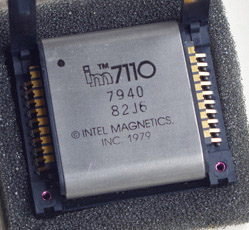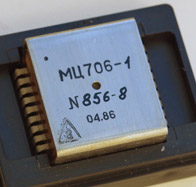Who remembers bubble memory? For a short while in the early 1980s it was going to be the next big thing in computer technology, then it was never heard of again. Prime "Tomorrow's World" material. (A British TV program that never learned that predicting is difficult, especially about the future). What was it anyway? What happened to it?
Bubble memory was a weird technology, it was a kind of magnetic integrated circuit. A ferrimagnetic substrate was made from artificial garnet. Specially-shaped electrodes were deposited on the surface, and the whole thing was wrapped in two coils at right angles and sandwiched between two permanent magnets. By feeding out-of-phase waveforms to the coils and applying the right signals to the electrodes, tiny cylindrical magnetic domains nicknamed 'bubbles' - effectively tiny isolated magnets - could be created in the magnetic layer and shunted around in serial loops rather like the 'bit buckets' in a CCD, with the electrodes guiding them. Each domain could be in one of two states, creating the classic binary digit. Special electrodes could read and write the bit value as a domain was shunted past. A 'major-minor' loop design was used to shorten access time, but a drawback of the technology is that, like the CCD, it does not provide random-access to the data. The resulting 'module' was also bulky, heavy and power-hungry compared to a CMOS memory device. On the positive side, bubble memory is non-volatile: the content persists after power is removed, in common with other magnetic storage media.
For a few years around 1980, pundits all predicted that bubble memory was going to be the next major computer storage technology. In reality it never did become important commercially. CMOS transistor RAM memory, such as is still used today, proved to be cheaper and simpler to make, and a few technological advances suddenly increased the capacity of hard disk drives by orders of magnitude. Nevertheless, products incorporating bubble memory did make it to market as you can read below.
Inevitably, bubble memory technology attracted the interest of the military, because of its non-volatility, and also because it was claimed to be radiation-hard. It was incorporated in a number of systems for use on ships and aircraft, although details are scarce. There was a minor scandal in 1987 when a French firm was found to have been supplying the Soviet Union with technology for fabricating bubble memory devices. This is covered in sensationalistic detail in a broader article in The Iran Brief.
A culturally interesting use of bubble memory was in games consoles. In the 1980's the Japanese corporation Konami created an arcade games console system board called Bubble System that included a bubble memory cartridge, and shipped a number of games in this format. An oddity of this system was that Konami needed the memory to be heated to between 30 and 40 degrees Celsius, resulting in a warm-up delay after power-on reminiscent of thermionic tubes/valves. Few of these systems survive in working condition. I believe that Fujitsu was the manufacturer of the bubble memory module(s) used, but I don't know the part number(s) so if you do, or have any (in any condition), please
Below you can see my bubble memory module collection but I am still seeking examples of, and data about, many types. It is noted in the text where this is the case, so if you can help, please Note that I am happy to have non-working examples.
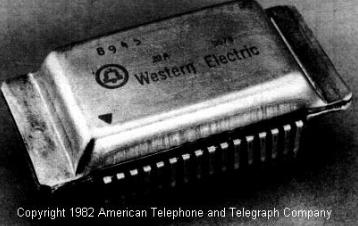
Bubble memory was invented at Bell Labs in the USA. By the mid 1970s many research organisations were interested in it. Experimental devices could store only a few Kilobits, but that was already a threat to the magnetic core memory technology used in computers of the time. Notable research was undertaken by Bell Labs, IBM, Crouzet and Plessey, as well as in Japan.
These early devices were not sold commercially, but the first bubble memory module, the Western Electric type 29A, was used by AT&T in the US telephone system to provide automated voice announcements. This package comprised four 68121-bit chips, making a total of 272484 bits, which could store twelve seconds of speech encoded at 24 Kbps. The chips were simple shift registers, without major-minor loop structure. I believe four of the modules were used on a single circuit board.
Needless to say I would like to have an example of the 29A in my collection, so if you know how I can get one, please
 Plessey Microsystems in England was a leading early researcher of bubble memory, but information about their products is scarce. I believe that they manufactured two bubble modules, the 64 Kbit PB064 and the 256 Kbit PB256. I suspect that these were used by the UK defence industry, and I do know that they were incorporated on cards for the "Portable Billing Machine (PBM)", a device for use by utilities meter readers.
Plessey Microsystems in England was a leading early researcher of bubble memory, but information about their products is scarce. I believe that they manufactured two bubble modules, the 64 Kbit PB064 and the 256 Kbit PB256. I suspect that these were used by the UK defence industry, and I do know that they were incorporated on cards for the "Portable Billing Machine (PBM)", a device for use by utilities meter readers.
In 1979 Plessey decided to stop making their own bubble modules and to concentrate on board-level systems, using modules from other manufacturers. They sold at least two bubble memory products using Rockwell bubble modules (see below), the PBS90M and PBS180M. (Plessey Microsystems split from the main Plessey Company in 1988 to form Radstone Technology). They also used Hitachi modules as shown below. The British magazine "Computer Age" in December 1980 published this rather poor image of Plessey's products.
I am very interested in Plessey bubble memory modules and the devices that used them such as the PBM. If you know anything about them, or where I can obtain them, please
 Crouzet S.A. in France were also a leader in magnetic memory technology, which they called moving domain (MOD) devices. These were fabricated on a nickel-cobalt substrate (i.e. not garnet) and did not need permanent magnets to provide a static magnetic field. Their devices apparently had 35000 bit capacity but I do not know their part numbers. They were used in a military digital television system, an avionics display refresh memory, and a prototype for a satellite memory.
Crouzet S.A. in France were also a leader in magnetic memory technology, which they called moving domain (MOD) devices. These were fabricated on a nickel-cobalt substrate (i.e. not garnet) and did not need permanent magnets to provide a static magnetic field. Their devices apparently had 35000 bit capacity but I do not know their part numbers. They were used in a military digital television system, an avionics display refresh memory, and a prototype for a satellite memory.
I am very interested in these devices. If you know anything at all about them, or where I can obtain them, please
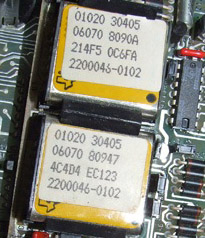
According to contemporary records, the first commercial bubble memory module was the TBM0103 announced by Texas Instruments (TI) in 1977. Oddly, its apparent prototype TBM0101 was mentioned instead, in this article in the BYTE magazine issue of June 1979. The TBM0103 was a 92 Kbit module that was used internally in some TI products. My image shows a pair of modules in such a TI device. The string of hexadecimal digits printed on the label stuck on each module is a mask that specifies which of the minor loops should not be used because of defects. The device's nominal capacity is less than its true physical capacity so that defective loops can be left unused. This is a feature of most of the modules shown below, although later types had the mask pre-stored in one of the minor loops by the manufacturer, so that the user did not have to read the label and program an EPROM on their board. Of course this meant that, instead, the module manufacturer had to test and program each module.
These should be TBM0103 modules, but any printed part number is covered by the labels. However I am intrigued by the final -0102 printed after the mask data. See my comments on TIBS0004 below for more information.
If you know about any TBM bubble memory module, please
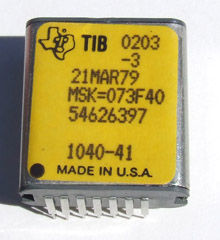
The TBM types were superseded quickly by the TIB0203 another 92 Kbit module introduced in 1978.
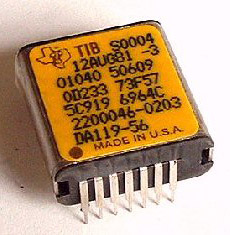
The TIB0203 was also short-lived and is hard to find, more common is the physically identical TIBS0004 shown. Both part numbers can be found with a variety of suffixes, 3 in the case of both my examples. A Web search reveals the existence of a TI data book for the TIB0203, but nothing for the TIBS0004. However, it is intriguing that the mask numbers are followed by -0203, in the same way that my TBM modules end with -0102. Does this indicate that the TIBS0004 is fundamentally a TIB0203, and my supposed TBM0103 modules are really TBM0102 (for which no data seem to exist)? On the Web, I can find only one image of a TI bubble module from a device similar to mine, and its number ends in -0101. Is it a TBM0101?
The TI numbering scheme sets a precedent that was followed by other manufacturers with variations: a major number that signifies the module capacity, followed by a minor number or character that signifies a technological variation on the basic design.
TI went on to release a 256 Kbit module TIB0303. I am very interested in obtaining an example of this.
If you have data about or examples of original TI bubble modules, or you know why TIB0203 was changed to TIBS0004, please I'm also interested in buying bubble memory cards from the TI "Silent 700" terminal model 763 or 765, working or not.

Puzzlingly, TI then developed a different series of high-capacity modules: TIB250, TIB500 and TIB1000. These were announced in 1979, at least the last was claimed to be almost available on boards, but I don't think they were ever actually sold. TI decided to abandon bubble memory production in 1981 along with Rockwell and National Semiconductor.
If you have know why TI created this new series, or have data about or examples of these TI modules, please
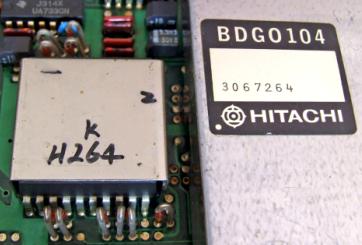
This module is the 64 Kbit BDG0104 made by Hitachi as shown on the label, which is stuck to a metal shielding plate that normally covers the device rather than to the module itself. (I have moved the plate aside in the image). Throughout the 1980's Hitachi produced a whole series of modules of various capacities (see BDJ0110 below) and used them on memory cards made by Fanuc and Okuma for CNC machines. The lowest capacity modules that I have found, and therefore probably the earliest, were BDG0103 and BDG0104, which have the same capacity and so I think they are variants of the same basic design. My module is on a Fanuc card type A87L-0001-0015 with chips on it dated 1983.
However, not all Fanuc card labels show the module number: some just have the mask of defective locations.
 I wish to find examples of the low-capacity Fujitsu modules FBM31DB and FBM32DA, as well as original data sheets for them.
If you know where I can obtain any, please
I wish to find examples of the low-capacity Fujitsu modules FBM31DB and FBM32DA, as well as original data sheets for them.
If you know where I can obtain any, please
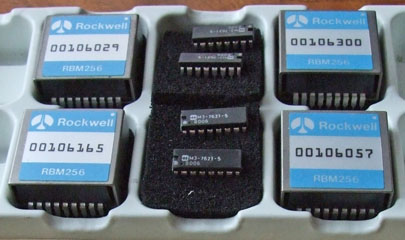
Many manufacturers entered the market with 256 Kilobit modules.
This rather chunky device is the 256 Kbit RBM256 made by Rockwell International. This was available on a memory expansion board for the legendary Rockwell AIM-65 computer, which used the 6502 microprocessor. My image shows a plastic container holding four of them plus some support chips; it was intended to hold ten modules. I also have four cards, about the same size as vintage computer punched cards, which have data on these modules including the defect mask.
In the late 1970s Rockwell agreed with Burroughs to exchange technical information and manufacturing assistance on bubble memories. Rockwell also licensed the German electronics giant Siemens as a second-source for its bubble memory products. I have never seen an image of a bubble module branded Burroughs or Siemens, and would be very interested in any.
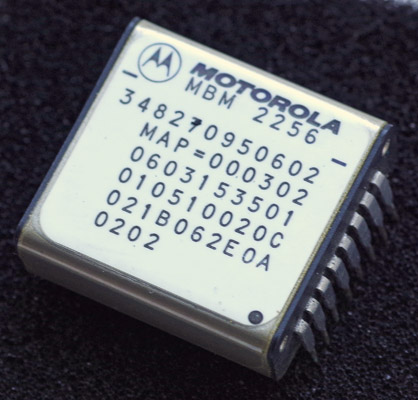
This is the Motorola MBM2256, another 256 Kbit type.
I am seeking the similar modules:
If you know of examples of any of these, please
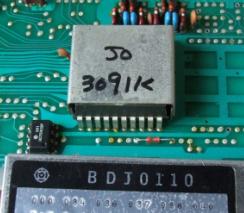
This module is the 256 Kbit BDJ0110 made by Hitachi, which I think is the second in capacity that they manufactured, as I have not seen any 128 Kbit examples. Again the label is on a shielding plate, but it is now too big to fit on the module. My example is on a Fanuc card type A87L-0001-0017 dated 1980/12. The same card type can also be found bearing a variation BDJ0113 that is also 256 Kbits. There are other Hitachi modules shown below, and from the part numbers one can deduce the capacity, which in principle goes up by a factor two each time, although not all values were manufactured:
- BDG010n - 64 Kbits
- BDH01nn - 128 Kbits - not made?
- BDJ011n - 256 Kbits
- BDK01nn(?) - 512 Kbits - I know a module of this capacity exists but I have not seen one
- BDL013n - 1 Mbits
- BDM01nn - 2 Mbits - not made?
- BDN015n - 4 Mbits
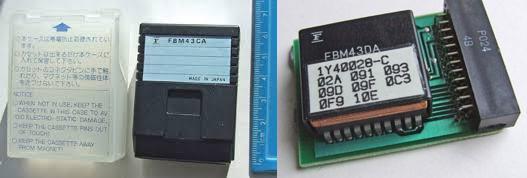
I have some small plastic cartridges marked "FBM43CA bubble memory cassette", in transparent plastic boxes with Japanese script on them plus an English translation. These were used in the Fujitsu FM-8 microcomputer and possibly in its relatively unknown predecessor the Bubcom 80, a computer named after its bubble memory. The same cassettes were used in digital oscilloscopes made by Nicolet, a US firm despite the French name, so Fujitsu must have been selling both cassettes and readers to other OEMs.
The cassette does not open readily, but I have succeeded in opening one to see the 256 Kbit Fujitsu module itself, which has the suffix DA, not CA, as shown. This seems to be common to several Fujitsu bubble memories: the C indicates a cassette that contains a module with the D suffix. This FBM43DA is also unusual in having a visible coil wound around it. I believe this is a so-called 'z-coil' that is used for thermal compensation, and may also be used to erase the entire module with a single pulse. The cassette has a sliding switch on it, which I assume is a write-protect switch, but it is not clear at all what effect the switch has!
There is a warning on the cassette about not touching the pins of the connector (which are not visible but are inside the black plastic housing on the right on the image), as the contents are static-sensitive. The cassette is the subject of US patent 4459680, and the third figure in the patent shows a support chip inside as well as the memory module. However, no such chip exists in the cassette that I have opened.
There are similar Fujitsu cassettes with different capacity modules inside. I have only one, marked FBM-C128GA. It is easily unscrewed open and contains an FBM54DB 1 Mbit module. Apparently they changed the numbering system from the obscure module number to a byte capacity value (1M bits = 128K Bytes).
There is also a Fujitsu 256 Kbit module FBM42DA. I would be interested to obtain an example, so if you know where I can get one, please

The Soviet Union had a number of bubble memory manufacturers. Сапфир ("Sapphire") in Moscow was one of these. The type К1602РЦ1 is its lowest capacity module. That linked data sheet shows that it came in three variants:
- К1602РЦ1A is a 90 Kbit type.
- К1602РЦ1Б is a 64 Kbit type.
- К1602РЦ1B is a 32 Kbit type.
I am seeking examples of К1602РЦ1, if you know how I can get any, please
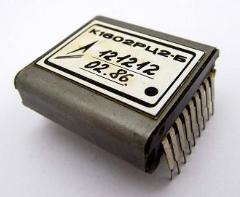
Sapphire's next module is the К1602РЦ2 shown. That linked page states that it is (approximately) a 256 Kbit type, but, as with the К1602РЦ1, the full capacity version has a suffix A. The suffix Б, as in my example, denotes that a failure in one half has been masked off resulting in a 128 Kbit device, and another suffix Cyrillic В (latin V) can be found, indicating a further reduction to a 64 Kbit version.
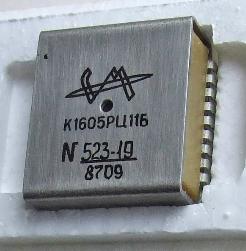
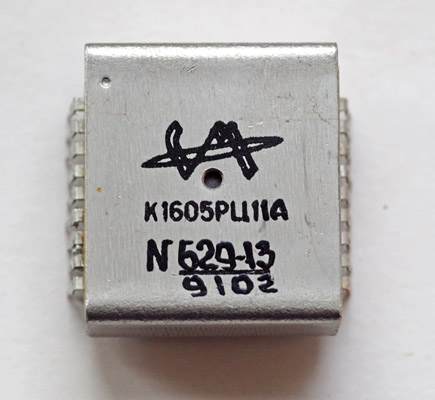 This К1605РЦ1 is another Soviet Union bubble memory module, made by Элма ("Elma") from Zelenograd. In unused condition it comes in a polystyrene box with a label and an internal note with masking information. That linked page states that its capacity is approximately 256 Kbits. There are a number of suffixes which, rather than capacity, denote its temperature characteristics:
К1605РЦ1,
К1605РЦ1A,
К1605РЦ1Б,
К1605РЦ11A (shown),
К1605РЦ11Б (shown),
К1605РЦ11B,
К1605РЦ11A1,
К1605РЦ11Б1.
Unlike all other bubble memory modules, it uses a yellow-brown plastic filler under the steel magnetic shield, rather than black plastic.
This К1605РЦ1 is another Soviet Union bubble memory module, made by Элма ("Elma") from Zelenograd. In unused condition it comes in a polystyrene box with a label and an internal note with masking information. That linked page states that its capacity is approximately 256 Kbits. There are a number of suffixes which, rather than capacity, denote its temperature characteristics:
К1605РЦ1,
К1605РЦ1A,
К1605РЦ1Б,
К1605РЦ11A (shown),
К1605РЦ11Б (shown),
К1605РЦ11B,
К1605РЦ11A1,
К1605РЦ11Б1.
Unlike all other bubble memory modules, it uses a yellow-brown plastic filler under the steel magnetic shield, rather than black plastic.
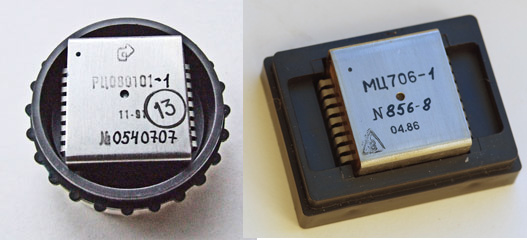
Here is another Soviet Union bubble memory module, РЦ080101, made by a manufacturer that survives today, физика (anglicised as "Physics"). It also is a 256 Kbit module, and sometimes the part number is prefixed by К, which I think denotes a non-military version. It appears to have a suffix -1 but I know of no other suffix values.
My image shows it in its unusual orginal plastic package, a cylinder with scalloped grips, both ends of which have removable caps. One end contains the module itself, the other a small paper sheet printed with the defect mask. I am indebted to Eduard Denisov for providing me with this module.
Originally this module was designated MЦ706 (latin MC706) and my compound image shows this rare variant.
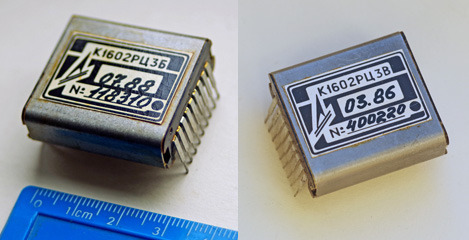 The next wave of bubble memories had 1 Megabit capacity.
The К1602РЦ3 by Sapphire (see above) is one. Again the full capacity version has a suffix A but my example has the suffix Б denoting that a failure in one half has been masked off resulting in a 512 Kbit device, a most unusual capacity. My image also shows an example of the suffix Cyrillic В (Latin V) version, indicating a further reduction to 256 Kbits. It is questionable how many full 'A' modules were actually made.
The next wave of bubble memories had 1 Megabit capacity.
The К1602РЦ3 by Sapphire (see above) is one. Again the full capacity version has a suffix A but my example has the suffix Б denoting that a failure in one half has been masked off resulting in a 512 Kbit device, a most unusual capacity. My image also shows an example of the suffix Cyrillic В (Latin V) version, indicating a further reduction to 256 Kbits. It is questionable how many full 'A' modules were actually made.
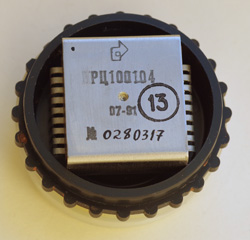 физика ("Physics") also made a 1 Mbit bubble memory module, the РЦ100104 as shown, which also may have the prefix К. That linked page raises the question of whether this module ever actually worked.
физика ("Physics") also made a 1 Mbit bubble memory module, the РЦ100104 as shown, which also may have the prefix К. That linked page raises the question of whether this module ever actually worked.
 The most widespread 1 Mbit type was that made by Intel, of PC processor fame. They licensed technology from IBM and manufactured the 1 Mbit 7110 module shown (various suffixes exist, as is the case with many of the other modules shown here). Intel incorporated their modules on development boards of various kinds, often emulating a floppy-disk drive in order to circumvent the serial-access limitations of the technology. The oldest ones look like the leftmost image, more recent ones have the defect mask printed on them. They may be branded Intel Magnetics, just Intel, or Memtech, a management buyout of the magnetics division in 1987.
The most widespread 1 Mbit type was that made by Intel, of PC processor fame. They licensed technology from IBM and manufactured the 1 Mbit 7110 module shown (various suffixes exist, as is the case with many of the other modules shown here). Intel incorporated their modules on development boards of various kinds, often emulating a floppy-disk drive in order to circumvent the serial-access limitations of the technology. The oldest ones look like the leftmost image, more recent ones have the defect mask printed on them. They may be branded Intel Magnetics, just Intel, or Memtech, a management buyout of the magnetics division in 1987.
The Intel Bubble Memory Design Handbook for 1979 describes a type 7112 that is also a 1 Mbit memory but with twice the speed of the 7110. I have never seen images or examples of such a module, so if you know about it, please
Intel persisted with bubble memory manufacture despite other major companies abandonment in 1981, and Memtech continued with the technology until the late 1980s before turning to flash memory instead.
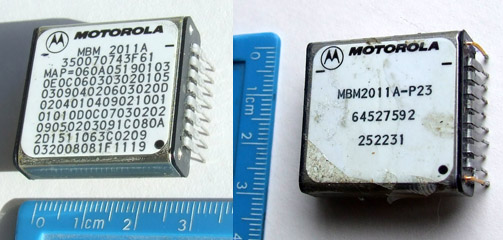 This MBM2011A is a rare 1 Megabit type made by Motorola, which followed on from their MBM2256. I also have one marked MBM2011A-P23 but I don't know what the suffix signifies. Motorola also seem to have second-sourced the Intel 7110: at least, I have seen an image of a Motorola module numbered 7110.
This MBM2011A is a rare 1 Megabit type made by Motorola, which followed on from their MBM2256. I also have one marked MBM2011A-P23 but I don't know what the suffix signifies. Motorola also seem to have second-sourced the Intel 7110: at least, I have seen an image of a Motorola module numbered 7110.
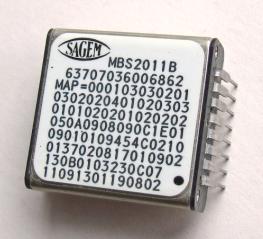 This MBS2011B is also a rare 1 Megabit type, branded SAGEM, which was a French electronics company that seems to have mainly sold to the military. Their bubble memory systems were used in Mirage aircraft. Apparently SAGEM also made a data recorder (EBS 2801) system used on the SIGMA, EURECA 1, and SPOT 4 satellites. The memory capacity of the recorder ranged from 4 to 32 Mbytes. I don't know whether this used the MBS2011 or the smaller MBS2256.
This MBS2011B is also a rare 1 Megabit type, branded SAGEM, which was a French electronics company that seems to have mainly sold to the military. Their bubble memory systems were used in Mirage aircraft. Apparently SAGEM also made a data recorder (EBS 2801) system used on the SIGMA, EURECA 1, and SPOT 4 satellites. The memory capacity of the recorder ranged from 4 to 32 Mbytes. I don't know whether this used the MBS2011 or the smaller MBS2256.
However, the similarity with the above Motorola module is obvious. The two companies, plus also National Semiconductor, used the part numbers 2256 and 2011 for modules with 256 Kbit and 1 Mbit capacity, albeit with different prefixes and suffixes. The similarity in number and appearance suggests that the three companies had a manufacturing relationship, even if they each had their own research departments. If you can explain this, please
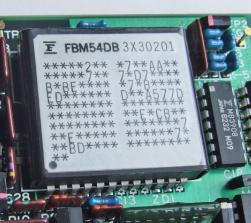 This FBM54DB is a 1 Mbit Fujitsu type. It is mounted on a small card with several Fujitsu LSI chips on it, and came in an anti-static bag that is marked FACOM, the brand name for Fujitsu computers. It looks a lot like an equivalent of the Intel BPK-72 bubble memory evaluation board. I suspect that the module is logically split in two halves, as indicated by the two sets of numbers on it. This may even reflect two physical garnet dies internally, as suggested by the larger number of pins than the Intel 7110. Some examples of FBM54DB are simply painted black with no defect mask; I am unsure if these are early ones.
This FBM54DB is a 1 Mbit Fujitsu type. It is mounted on a small card with several Fujitsu LSI chips on it, and came in an anti-static bag that is marked FACOM, the brand name for Fujitsu computers. It looks a lot like an equivalent of the Intel BPK-72 bubble memory evaluation board. I suspect that the module is logically split in two halves, as indicated by the two sets of numbers on it. This may even reflect two physical garnet dies internally, as suggested by the larger number of pins than the Intel 7110. Some examples of FBM54DB are simply painted black with no defect mask; I am unsure if these are early ones.
I also have an FBM54DB mounted on a small card, with apparently other components sealed under a coating, and rows of pins on two opposite sides that make the whole assembly a kind of giant DIL module. This is described in US patent 4710895 A. It was sold to me simply as an FBM54DB.
I have no original data for the FBM54DB, please contact me if you can provide any. There may also have existed a 1 Mbit FBM53DA, I would also be interested in it.
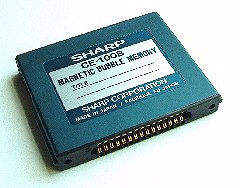 This image shows a magnetic bubble memory cartridge for the Sharp PC5000 MS-DOS computer. Although I have not opened it, I know that it contains a Hitachi 1 Megabit bubble memory module. The Web shows several examples of this cartridge, even one that has been opened, but the part number is not specified. Hitachi made at least three variants of a 1 Mb type, the BDL0131, BDL0133 and BDL0134. I don't know which is in my cartridge.
This image shows a magnetic bubble memory cartridge for the Sharp PC5000 MS-DOS computer. Although I have not opened it, I know that it contains a Hitachi 1 Megabit bubble memory module. The Web shows several examples of this cartridge, even one that has been opened, but the part number is not specified. Hitachi made at least three variants of a 1 Mb type, the BDL0131, BDL0133 and BDL0134. I don't know which is in my cartridge.
If you can help elucidate this, please
 The most desirable 1 Mbit types that I am seeking are the NBM2011 from National Semiconductor, and the Rockwell RBM411 and RBM413. I am also looking for original data sheets for these and for many of the above types.
If you have data about or examples of any of the above modules, or know where I can obtain them, please
The most desirable 1 Mbit types that I am seeking are the NBM2011 from National Semiconductor, and the Rockwell RBM411 and RBM413. I am also looking for original data sheets for these and for many of the above types.
If you have data about or examples of any of the above modules, or know where I can obtain them, please
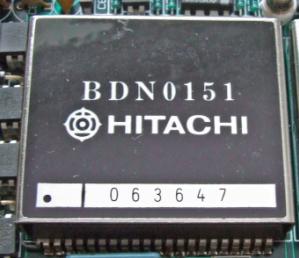
The greatest capacity devices that made it to market were 4 Megabit types. This Hitachi BDN0151 and the BDN0153 below are nominally 4 Mbit types. However, Hitachi 'cheated' by encapsulating four 1 Mbit dies in a single package. Consequently the two types have a bigger module with very many more pins than all the other bubble memories shown here.
I don't know how the BDN0151 differs from the BDN0153 because I have no technical data for either of them. I suspect that the last digit in Hitachi module numbers is a kind of suffix that indicates a variation on one basic device type. I have a pair of BDN0151 on a VMEbus card, made by Plessey Microsystems. If you have data about either of these, please
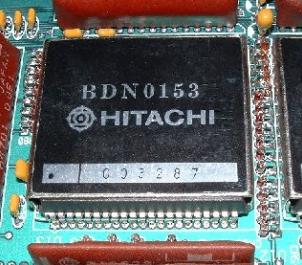 This Hitachi 4 Mb BDN0153 bubble memory module is one of three on a standard ISA-bus card type PCH-3 that I possess, for use in older personal computers, made by Bubbl-tec, a marketing "division" of Pacific Cyber/Metrix, Inc. It was advertised in PC Magazine for March 31, 1987 where it was claimed to be more rugged than magnetic disks. My example came with a 5.25 inch floppy disk containing MSDOS driver software. Although I have successfully added the necessary floppy drive to a modern PC, it gives an error on trying to read the diskette.
The former president of the company has informed me that they used bubble memory modules from at least three vendors, but he had no technical data on their cards. Some of their other products can be found using Web searches:
This Hitachi 4 Mb BDN0153 bubble memory module is one of three on a standard ISA-bus card type PCH-3 that I possess, for use in older personal computers, made by Bubbl-tec, a marketing "division" of Pacific Cyber/Metrix, Inc. It was advertised in PC Magazine for March 31, 1987 where it was claimed to be more rugged than magnetic disks. My example came with a 5.25 inch floppy disk containing MSDOS driver software. Although I have successfully added the necessary floppy drive to a modern PC, it gives an error on trying to read the diskette.
The former president of the company has informed me that they used bubble memory modules from at least three vendors, but he had no technical data on their cards. Some of their other products can be found using Web searches:
- The MBC-11 controller board supported up to sixteen MBB-11 Bubbl-Pac boards, each holding four TI 92 Kbit bubble memory modules giving a total of 46 Kbytes of storage. This was a DEC LSI-11 memory system. It must have been one of their early products.
- The VMH-1 Bubbl-Board was a 512 Kbit VME bus memory board that used plug-in cartridges.
- The BBC128 was a single-board computer with an Intel 7110 on it, giving 128 Kbytes of non-volatile storage.
- The BDH-1 Bubbl-Dec was a standard-sized drive unit that accepted one or two BPH-1 plug-in 128 Kbyte bubble memory cartridges rather than floppy disks. It was available for a number of system buses: VMEbus, STD-bus, Multibus, Versabus, IBM-PC bus, and others.
- the QSB-11 Bubbl-Board was a 1 Mbit Qbus memory board for DEC VAX computers using an Intel 7110, it emulated an 8 inch floppy drive. It was superseded by the QFI-11 board that used a single Intel 7114 to provide 4 Mbits of memory.
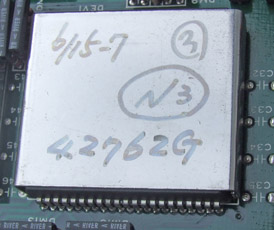 A number of contemporary descriptions of the bubble memory market state that the Nippon Electric Company (NEC) made bubble memories, however the Web contains no information about these except for the original patents relating to the technology. which never give a part number. I suspect that NEC did not market the devices, but only used them internally, although they may also have been used in equipment branded Panasonic.
A number of contemporary descriptions of the bubble memory market state that the Nippon Electric Company (NEC) made bubble memories, however the Web contains no information about these except for the original patents relating to the technology. which never give a part number. I suspect that NEC did not market the devices, but only used them internally, although they may also have been used in equipment branded Panasonic.
I have managed to purchase an NEC bubble memory card intended for use in telephone exchange equipment. It bears two modules as shown, which use a package very similar to the Hitachi ones above, the number of pins suggesting that they also are 4x1 Mbit types. However they have only handwritten markings, which suggest that their part number might be N3. (Hitachi used internal development numbers H3M, H8M etc).
If you have data about or examples of any NEC bubble memory, or know where I can obtain any, please
 I believe that Fujitsu may also have made a 4 Mbit module, the FBM64DA mentioned in this patent, however I know nothing else about it.
If you have data or examples, please
I believe that Fujitsu may also have made a 4 Mbit module, the FBM64DA mentioned in this patent, however I know nothing else about it.
If you have data or examples, please
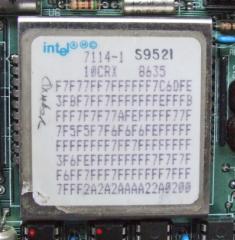 The only true 4 Mbit commercial type of which I'm aware is the Intel 7114. Intel managed to reduce the size of the features on the garnet sufficiently to create this capacity. The module is physically bigger than the 7110 but has the same number of pins. Later examples are branded MemTech, the buyout of Intel Magnetics.
The only true 4 Mbit commercial type of which I'm aware is the Intel 7114. Intel managed to reduce the size of the features on the garnet sufficiently to create this capacity. The module is physically bigger than the 7110 but has the same number of pins. Later examples are branded MemTech, the buyout of Intel Magnetics.
My image shows a 7114-1 on the Bubbl-Tec QFI-11 Qbus memory board mentioned above. The card also has a Z80 CPU on it, and an Intel 7225 controller, rather than the 7220 that was used with the 7110 module.
 Intriguingly, the Soviet Union manufacturer Sapphire also may have made a 4 Mbit types К1602РЦ5 and К1602РЦ9, or at at least displayed a prototype in 1986. What is even more astonishing, they displayed what seems to be a prototype 16 Mbit type Б420A. Were these real?
I am interested in all of these. If you know anything about any of these Soviet bubble memories, please
Intriguingly, the Soviet Union manufacturer Sapphire also may have made a 4 Mbit types К1602РЦ5 and К1602РЦ9, or at at least displayed a prototype in 1986. What is even more astonishing, they displayed what seems to be a prototype 16 Mbit type Б420A. Were these real?
I am interested in all of these. If you know anything about any of these Soviet bubble memories, please
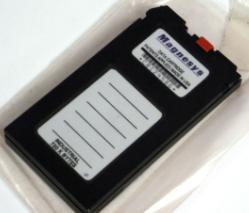 I possess the interesting device shown on the right. It is the size of a small smartphone, but much heavier. It is marked "Magnesys DATA CARTRIDGE PATENTS APPLIED / MADE IN USA" and "INDUSTRIAL 720 K BYTES". The case is made of sheet steel, and the red plastic sliding tab has one end marked WP, for "write protect". The same end of the casing holds a recessed female connector for a 42 pin plug. Magnesys were a start-up company in Santa Clara, who manufactured bubble memories. They were founded in 1983, and were acquired by Group Technologies Corp. in 1990. They specialised in ruggedised bubble memories for military and industrial use. 720 KBytes is the capacity of a double-sided 3½ inch floppy disk, which this device emulated. A former employee, Roy Urich, has told me that Magnesys manufactured all of it except the raw garnet wafers that came from Japan, and the custom LSI logic chip in the drive unit. The printed circuit board soldering was outsourced for the electronic drive units in the later years. Magnesys did the wafer production, wafer testing, die attach, electronic assembly and testing. Honeywell was their largest customer. It was used in a US Army battlefield radio back pack. Magnesys produced over 800 of the cartridges in 720K and 360K sizes.
I possess the interesting device shown on the right. It is the size of a small smartphone, but much heavier. It is marked "Magnesys DATA CARTRIDGE PATENTS APPLIED / MADE IN USA" and "INDUSTRIAL 720 K BYTES". The case is made of sheet steel, and the red plastic sliding tab has one end marked WP, for "write protect". The same end of the casing holds a recessed female connector for a 42 pin plug. Magnesys were a start-up company in Santa Clara, who manufactured bubble memories. They were founded in 1983, and were acquired by Group Technologies Corp. in 1990. They specialised in ruggedised bubble memories for military and industrial use. 720 KBytes is the capacity of a double-sided 3½ inch floppy disk, which this device emulated. A former employee, Roy Urich, has told me that Magnesys manufactured all of it except the raw garnet wafers that came from Japan, and the custom LSI logic chip in the drive unit. The printed circuit board soldering was outsourced for the electronic drive units in the later years. Magnesys did the wafer production, wafer testing, die attach, electronic assembly and testing. Honeywell was their largest customer. It was used in a US Army battlefield radio back pack. Magnesys produced over 800 of the cartridges in 720K and 360K sizes.
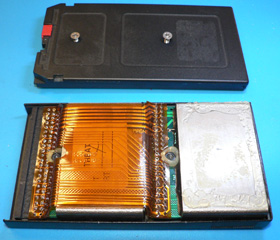 Another correspondent, Stan Drobac, has found how to open one of the cartridges. His image shows the electronics is hidden beneath metal plates, probably magnetic shielding.
Another correspondent, Stan Drobac, has found how to open one of the cartridges. His image shows the electronics is hidden beneath metal plates, probably magnetic shielding.
Magnesys also made a 720 KByte bubble memory PC card, called the "Electronic Drive Card". Again it was marketed as a rugged device for use "where floppy drives and hard disks don't survive".
If you know anything about Magnesys or their products, or where I can obtain them, please
 There seems to be a possibility that China researched bubble memory and may even have manufactured some. I did find a couple of Web pages that suggest this, but they were hosted on poor servers that now seem to have disappeared.
If you can provide any information about such Chinese work, please
There seems to be a possibility that China researched bubble memory and may even have manufactured some. I did find a couple of Web pages that suggest this, but they were hosted on poor servers that now seem to have disappeared.
If you can provide any information about such Chinese work, please
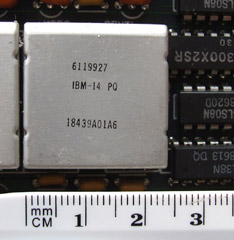 I bought an IBM circuit card containing four of these aluminium-cased modules, because I have seen Web articles claiming that they are IBM bubble memory. They have the right surface area, but they are not deep enough or heavy enough. There was a thread on classiccmp.org which concluded that these are 64 KByte CMOS DRAM chips and the card was designed specifically for use in the IBM Portable Personal Computer 5155. I have no original data on the chip itself, but a simple Web search gives the basics.
I bought an IBM circuit card containing four of these aluminium-cased modules, because I have seen Web articles claiming that they are IBM bubble memory. They have the right surface area, but they are not deep enough or heavy enough. There was a thread on classiccmp.org which concluded that these are 64 KByte CMOS DRAM chips and the card was designed specifically for use in the IBM Portable Personal Computer 5155. I have no original data on the chip itself, but a simple Web search gives the basics.
IBM did make bubble memory chips, but did not commercialise them. The only image that I have found of them shows a card with four large square blue-anodised aluminium-cased modules, with nothing printed on them. I am very interested in IBM bubble memory. If you know where I can obtain any, or any information about it, please
